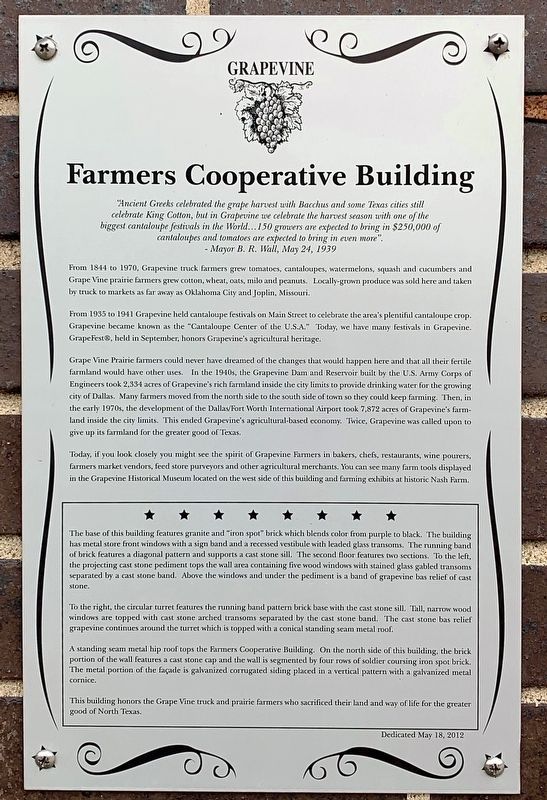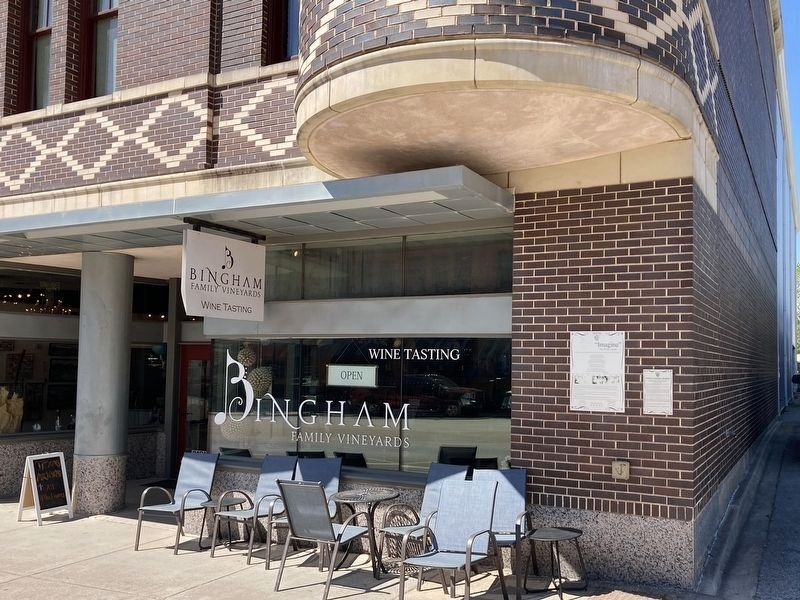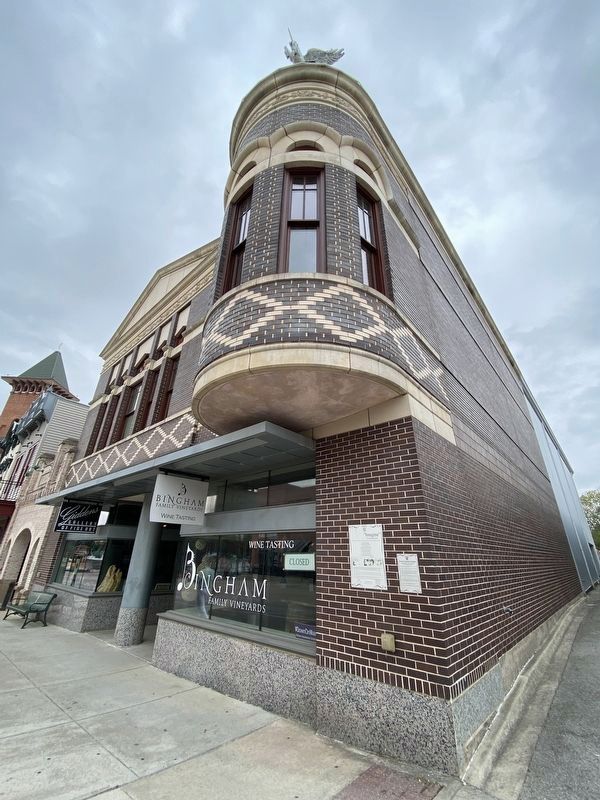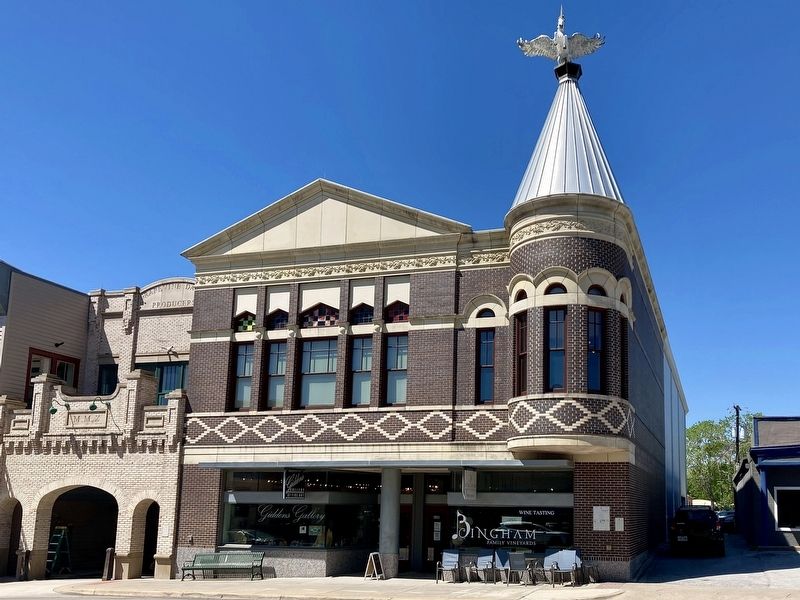Grapevine in Tarrant County, Texas — The American South (West South Central)
Farmers Cooperative Building
"Ancient Greeks celebrated the grape harvest with Bacchus and some Texas cities still celebrate King Cotton, but in Grapevine we celebrate the harvest season with one of the biggest cantaloupe festivals in the World...150 growers are expected to bring in $250,000 of cantaloupes and tomatoes are expected to bring in even more".
- Mayor B. R. Wall, May 24, 1939
From 1844 to 1970, Grapevine truck farmers grew tomatoes, cantaloupes, watermelons, squash and cucumbers and Grape Vine prairie farmers grew cotton, wheat, oats, milo and peanuts. Locally-grown produce was sold here and taken by truck to markets as far away as Oklahoma City and Joplin, Missouri.
From 1935 to 1941 Grapevine held cantaloupe festivals on Main Street to celebrate the area's plentiful cantaloupe crop. Grapevine became known as the "Cantaloupe Center of the U.S.A.” Today, we have many festivals in Grapevine. GrapeFest®, held in September, honors Grapevine's agricultural heritage.
Grape Vine Prairie farmers could never have dreamed of the changes that would happen here and that all their fertile In the 1940s, the Grapevine Dam and Reservoir built by the U.S. Army Corps of farmland would have other uses. Engineers took 2,334 acres of Grapevine's rich farmland inside the city limits to provide drinking water for the growing city of Dallas. Many farmers moved from the north side to the south side of town so they could keep farming. Then, in the early 1970s, the development of the Dallas/Fort Worth International Airport took 7,872 acres of Grapevine's farmland inside the city limits. This ended Grapevine's agricultural-based economy. Twice, Grapevine was called upon to give up its farmland for the greater good of Texas.
Today, if you look closely you might see the spirit of Grapevine Farmers in bakers, chefs, restaurants, wine pourers, farmers market vendors, feed store purveyors and other agricultural merchants. You can see many farm tools displayed in the Grapevine Historical Museum located on the west side of this building and farming exhibits at historic Nash Farm.
The base of this building features granite and "iron spot” brick which blends color from purple to black. The building has metal store front windows with a sign band and a recessed vestibule with leaded glass transoms. The running band of brick features a diagonal pattern and supports a cast stone sill. The second floor features two sections. To the left, the projecting cast stone pediment tops the wall area containing five wood windows with stained glass gabled transoms separated by a cast stone band. Above the windows and under the pediment is a band of grapevine bas relief of cast stone.
To the right, the circular turret features the running band pattern brick base with the cast stone sill. Tall, narrow wood windows are topped with cast stone arched transoms separated by the cast stone band. The cast stone bas relief grapevine continues around the turret which is topped with a conical standing seam metal roof.
A standing seam metal hip roof tops the Farmers Cooperative Building. On the north side of this building, the brick portion of the wall features a cast stone cap and the wall is segmented by four rows of soldier coursing iron spot brick. The metal portion of the façade is galvanized corrugated siding placed in a vertical pattern with a galvanized metal cornice.
This building honors the Grape Vine truck and prairie farmers who sacrificed their land and way of life for the greater good of North Texas.
Erected 2012.
Topics. This historical marker is listed in these topic lists: Agriculture • Industry & Commerce. A significant historical year for this entry is 1844.
Location. 32° 56.159′ N, 97° 4.709′ W. Marker is in Grapevine, Texas, in Tarrant County. Marker is on Main Street south of Franklin Street, on the right when traveling south. Touch for map. Marker is in this post office area: Grapevine TX 76051, United States of America. Touch for directions.
Other nearby markers. At least 8 other markers are within walking distance of this marker. J.E. Foust & Son (within shouting distance of this marker); The Grape Vine Prairie (within shouting distance of this marker); Grapevine Calaboose (within shouting distance of this marker); Willhoite's Restaurant (within shouting distance of this marker); Willhoite Tire and Home Store (about 300 feet away, measured in a direct line); Austin Drugs / Grapevine Post Office (about 300 feet away); Koonce Bros. / Buckner's Grocery (about 400 feet away); Grapevine Dairy Producers Building (about 400 feet away). Touch for a list and map of all markers in Grapevine.
Credits. This page was last revised on April 15, 2024. It was originally submitted on March 28, 2022, by Thomas Smith of Waterloo, Ill. This page has been viewed 140 times since then and 38 times this year. Photos: 1. submitted on March 28, 2022, by Thomas Smith of Waterloo, Ill. 2. submitted on April 15, 2024, by Craig Baker of Sylmar, California. 3. submitted on September 20, 2023, by Morgan Petermann of Irving, Texas. 4. submitted on April 15, 2024, by Craig Baker of Sylmar, California. • J. Makali Bruton was the editor who published this page.



